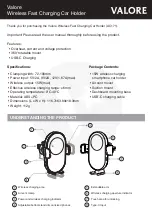
NovaLynx Corporation________________________________________________________________________________
200-WS-21-A
Page 9
February 2021
Roof mounted sensors should be placed on the upwind side of the building and away from all exhaust
vents. If the sensor is located on top of a building the sensor height should be 1.5 x H, where H is the
height of the building.
In all cases when the wind sensor data is to be correlated to National Weather Service data or World
Meteorological Organization data, the standard exposure is 33 feet (10 meters) above the ground.
5.2
Anemometer Mounting
CAUTION: Be careful when working on equipment that is mounted above you. Do not allow others to
stand below when equipment is being installed as falling objects can be hazardous.
The 200-WS-01B anemometer is usually mounted at the top of a supporting mast. The base of the
sensor accepts ¾" IPS pipe size or any other 1" to 1-1/16" (25 to 27 mm) outside diameter pipe. If the
anemometer cannot be mounted at the top of a mast, the NovaLynx 200-153 Mounting Arm
(sold
separately) can be used to mount the sensor to the side.
The supporting mast or tower should be properly grounded to minimize lightning damage. Where
lightning strikes are likely a lightning rod above the level of the sensor, preferably on a separate tower,
should be installed.
Position the wind sensor onto the end of the mast or mounting arm. Secure the sensor to the mast
using the set screws provided in the sensor base. Do not use excessive force when tightening the
screws.
5.3
Cable Installation
The PVC jacket of the cable will last for many years outdoors under normal circumstances. In harsh
environments it may be necessary to protect the cable with conduit.
Route the sensor cable down the mast and to the monitoring equipment in the most direct manner.
Leave a "drip loop" of cable below the entry point to the equipment enclosure to help keep moisture
out. Fasten the cable to the mast with cable ties to prevent whipping during high velocity winds. For
best results, use plastic cable ties that are resistant to ultra-violet radiation and place them at two foot
intervals. Do not over-tighten.
































